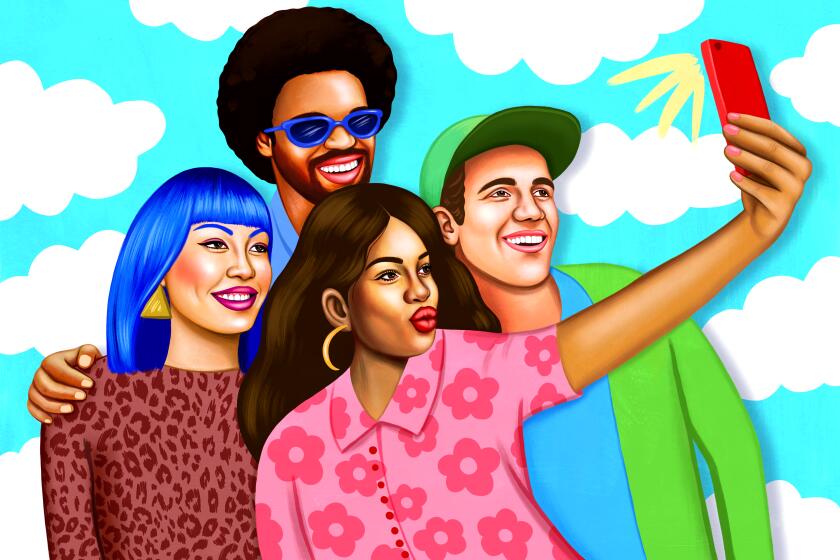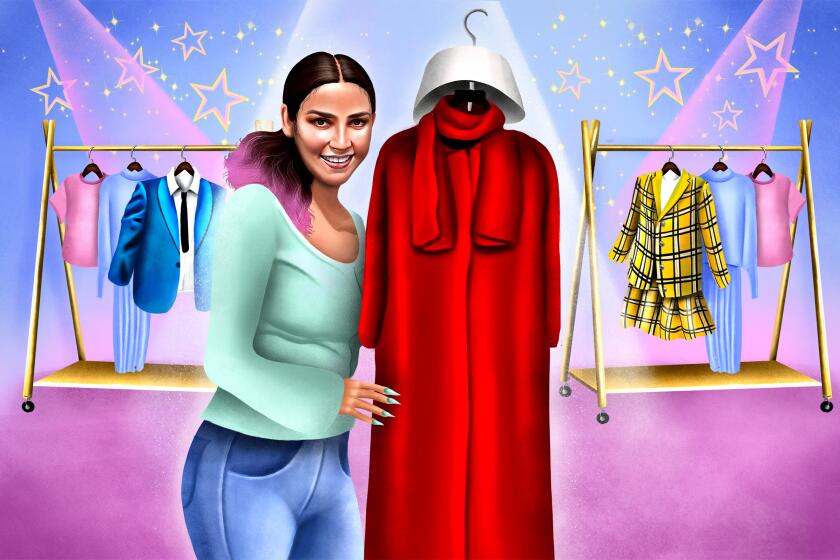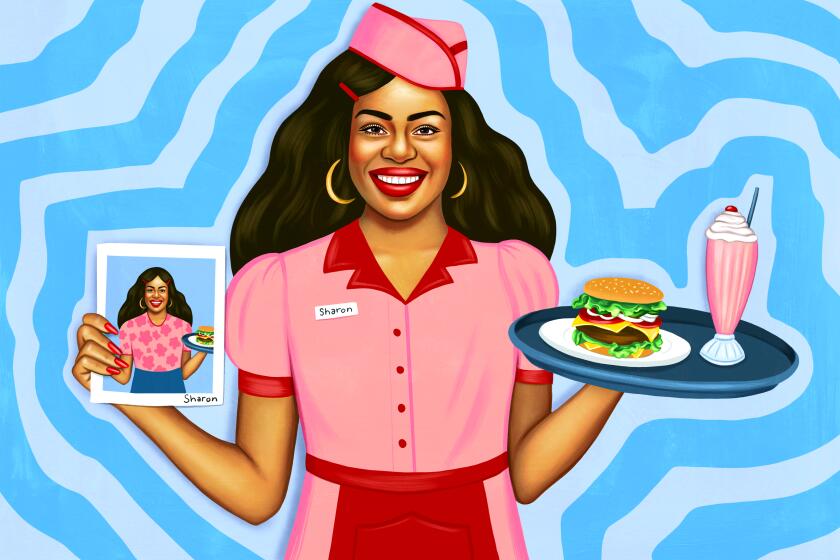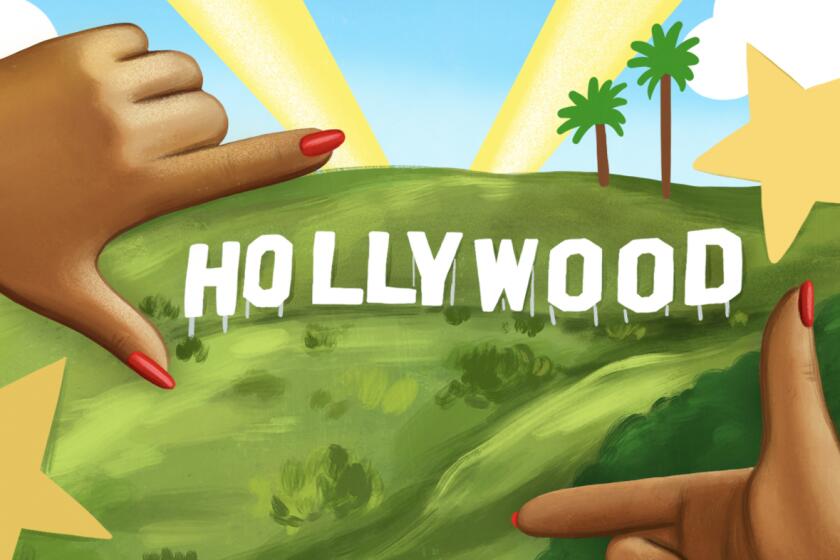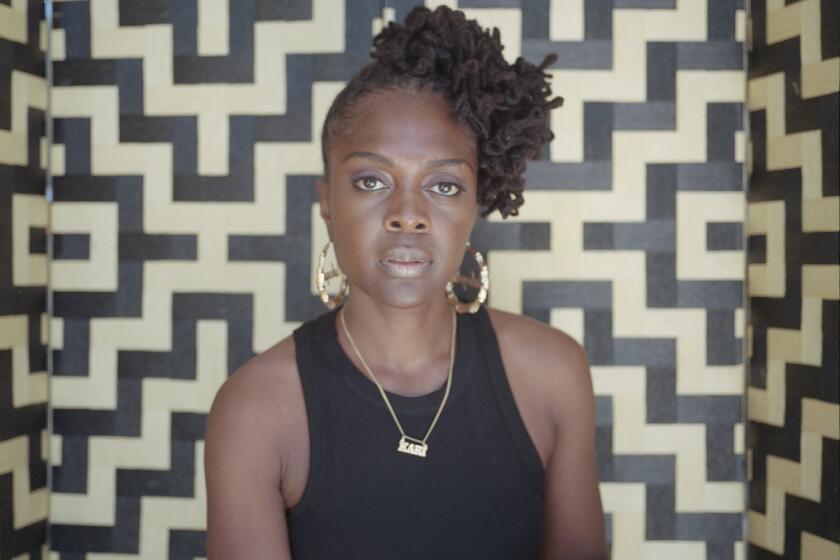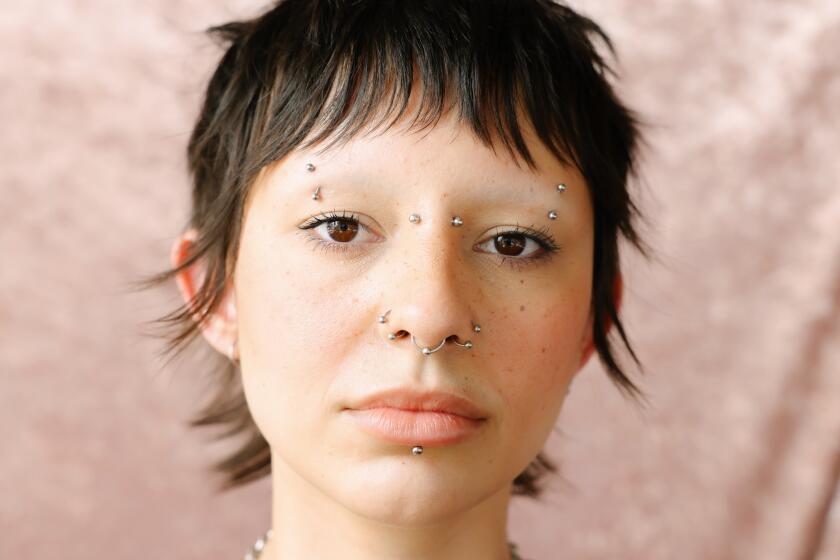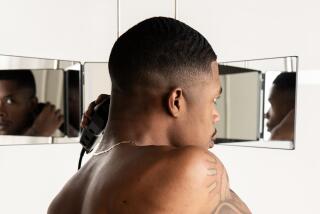Explaining Hollywood: How to get a job as a hairstylist
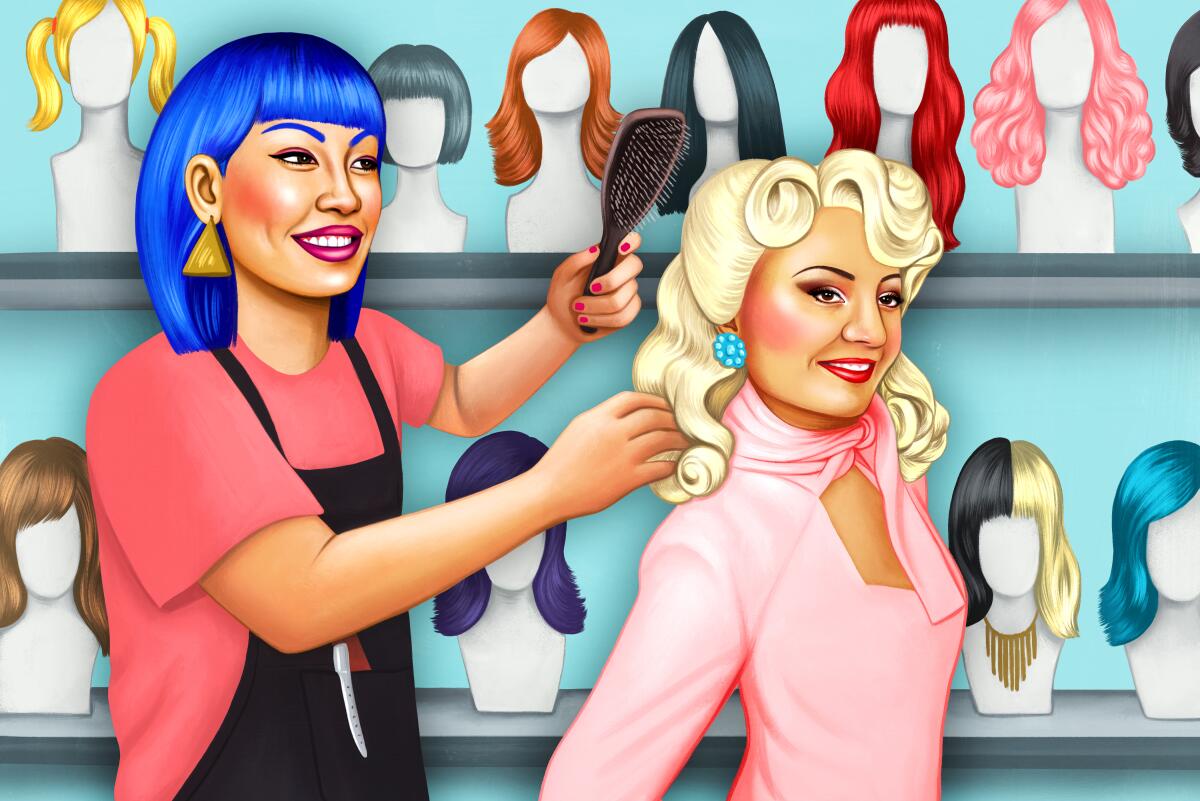
- Share via
In the multiverse-exploring film “Everything Everywhere All at Once,” Anissa Salazar had to come up with more than 20 different hairstyles for the key characters — at least one hairstyle per universe.
One of her favorites was the “Gothic Sailor Moon” look for Stephanie Hsu’s villainous Jobu Tupaki.
“I had made this hairpiece that imitated Sailor Moon’s bangs, and I gave her these extension space buns,” said Salazar, the film’s hair department head. “Then I wrapped this fake barbed wire that I had bought off Amazon, twirled it on the sides and put a bunch of silver star glitter that I had gotten from Tokyo on her hairline and roots. It was so fun.”
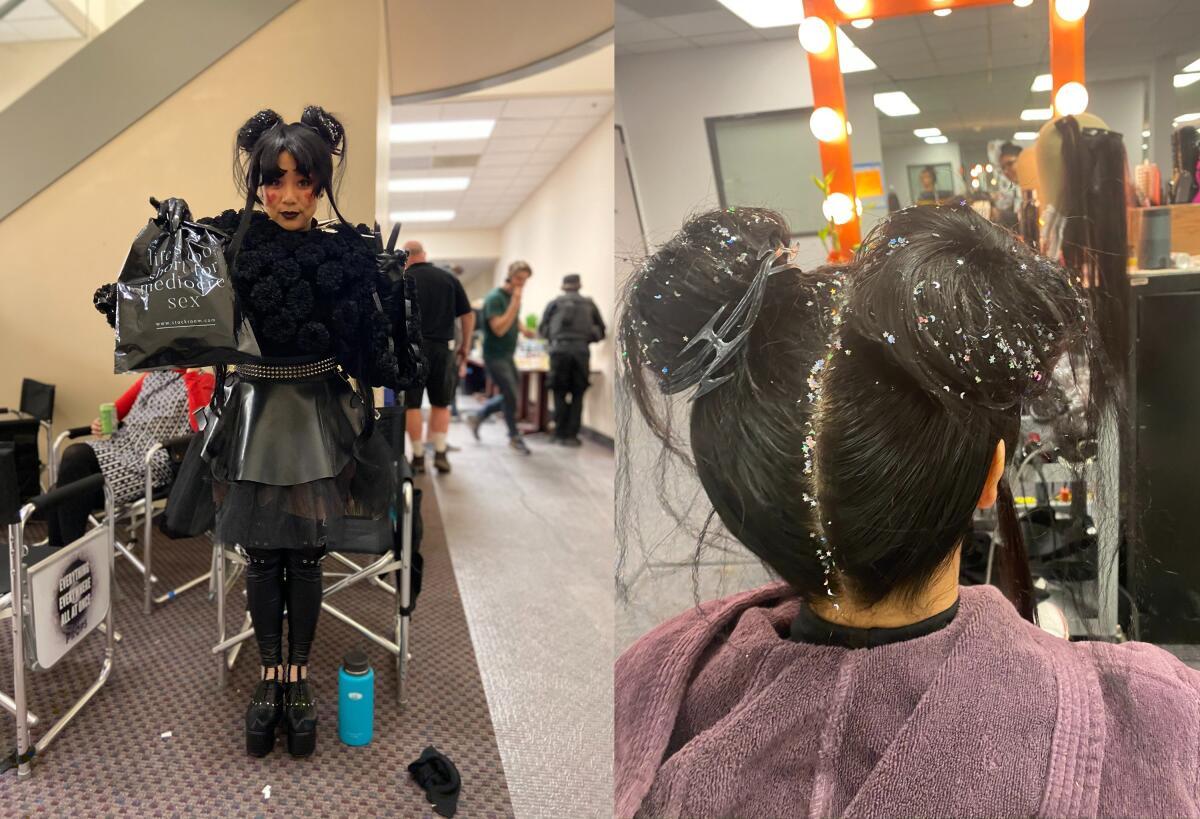
But at the same time, she’s equally proud of the main wig that Michelle Yeoh wore to embody Evelyn, the ordinary, exhausted, middle-aged laundromat owner.
“It looks disheveled for a reason, with the grays and the blotchy black on the left side,” she said. “It felt very familiar.”
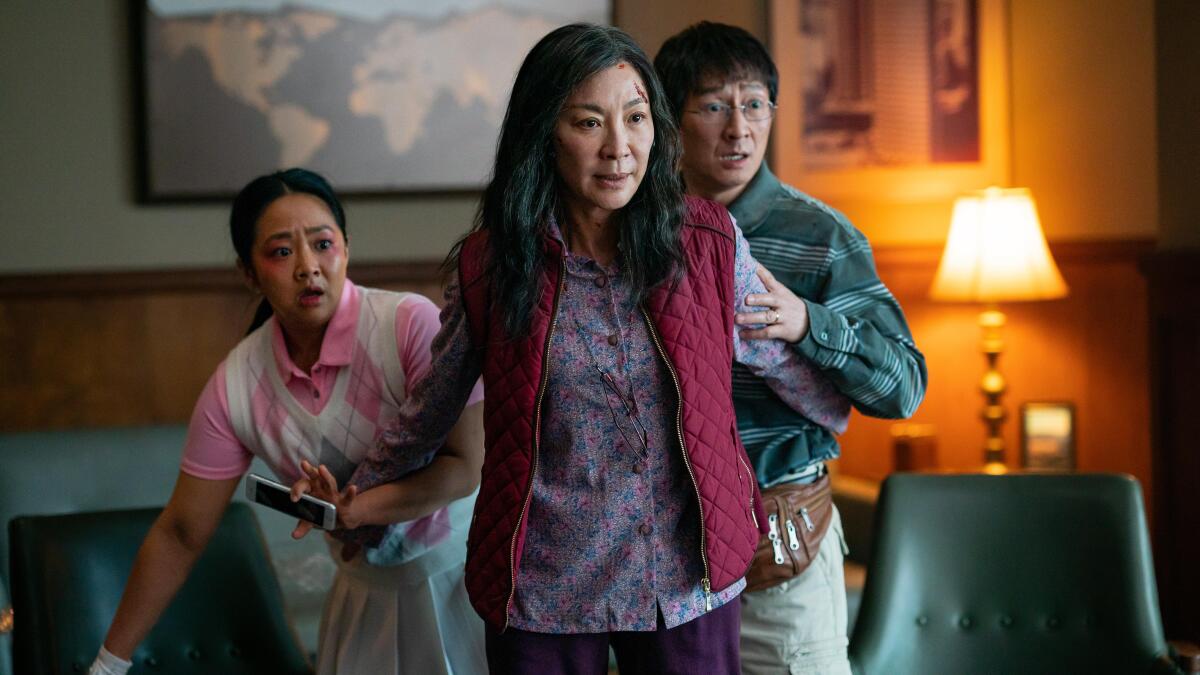
Hairstylists in Hollywood work with the projects’ creative team — including directors, showrunners, producers, actors, makeup artists and costume designers — to establish a character’s look.
Sometimes stylists are most satisfied when they’re able to make the wigs, extensions and other enhancements appear clean and seamless — especially in close-ups — because they know how hard it can be to make them look natural.
Other times, they revel in the showstopping looks. For the Amazon series “With Love,” Salazar designed an elaborate floral headpiece for Emeraude Toubia’s character, Lily, in the “Día De Los Muertos” episode.
“It had these marigolds, roses that represented the Virgin Mary’s blood sacrifice, and butterflies that signified eternity,” she said. “And I got to do these beautiful big Spanish waves on her. She looked stunning.”
To learn how to become a Hollywood hairstylist, The Times spoke with Camille Friend, veteran hair department head of numerous Marvel Studios projects and the founder of Hair Scholars; Susan Lipson, veteran hairstylist and founder of On Set Motion Picture Hair Academy; Guyla Wilkerson, a former salon suite owner who recently joined the union; Marva Stokes, a hairstylist who has worked on “Chip ‘n Dale: Rescue Rangers,” “Liza on Demand” and “Us”; and Salazar, who recently wrapped miniseries “The Santa Clauses” and will launch a new hair care line, Tecuane Hair, this summer. Here are some of their insights.
Who becomes a hairstylist in Hollywood?
Most of the professionals didn’t realize that working in Hollywood as a hairstylist was a career option for them when they were growing up. But they all had been doing hair for fun since they were young.
Stokes learned how to braid when she was 7. Lipson would cut her friends’ hair on the beach. Salazar remembers listening to señoras gossiping in her godmother’s salon and getting a gold star whenever she helped sweep the hair. Wilkerson spent so much time in the salon as a kid that she got bored and begged her mom to let her do her own hair at home. Soon, she was also doing hair for her mother, aunt and younger sisters.
And Friend is a third-generation hairstylist. The urban legend in her family is that her great-grandfather encouraged all his daughters to go to beauty school. Friend still has the certificate her grandmother earned at Madam C.J. Walker’s College of Beauty Culture in Indianapolis. Walker was a pioneer of modern Black hair care. Decades later, while Friend was working on “Black Panther,” she received an award from Walker’s Legacy Foundation — a meaningful full-circle moment for her.
“The salon is still one of the most comfortable places for me to be because it’s about community,” she said.

She and the other professionals were drawn to Hollywood because they loved combining their passion for hair with storytelling.
Salazar said when she was starting in Santa Barbara, her small portfolio was made of home projects where she had turned a friend into a zombie or given someone fantasy cotton candy hair. “Any time I’d apply at a salon, where there’s less space for wild looks, they’d be like, you belong in L.A.,” she said.
Friend said that the hairstylists who thrive in Hollywood are the ones who are both creative and curious. “Every movie, you have a different curiosity,” she said. “What is the period? What are the styles? Who are the actors? Who is the director? What is the production design?”
Lipson tells her students upfront that working in the film business is not just a career choice but also a lifestyle choice. Eighteen-hour days are common. Hairstylists are often the first ones on set and among the last ones to leave. You might not know where your next job is, and then all of a sudden, you have to pick up everything and go on location for nine months.
There are exceptions. Sitcoms tend to film only two days a week. Stylists looking for more reasonable hours could work on kids shows, said Stokes. Minors cannot work over 40 hours a week due to child labor laws.
In general, though, you have to be able to handle stress and adapt quickly to unpredictability, Lipson said. “Everything is urgent in film and TV,” she said. “When they’re ready to shoot, they’re ready. ... You have to be at your best all the time, which is really hard, especially when you’re working long hours.”
Rejection and uncertainty are part of working in Hollywood, but joy, creativity and fun can be too. Here’s how to manage your mental health.
How do you get started?
Your first step should be beauty school, said Friend. This is crucial not only because you need a cosmetology license in order to get into the union but also because you need a solid foundation.
“Make sure that you know how to blow-dry hair really well,” she said. “Make sure you know how to curl hair very well. Make sure you know how to flat iron hair very well. Make sure you know period hairstylings, the difference between the shapes of the hair in the ’50s, ’60s and ’70s.”
It’s also important to understand how wigs work — how to design and style wigs, as well as how to distribute different types of hair underneath a wrap in order for the wig to fit perfectly. Hairstylists in Hollywood often work with wigs if the production can afford it because it’s much easier, Lipson said. It’s less of a challenge to achieve continuity from shoot to shoot working with wigs, and many actors prefer not to have to sit in the chair for hours and have their hair damaged.
Classes you can take after beauty school teach wig making and other techniques specific to doing hair for the camera. You need to understand lighting, but you also need to understand how to break down a script.
Friend’s Hair Scholars — where Wilkerson and Stokes trained — and Lipson’s On Set provide mentorship for newcomers interested in learning the basics of the industry. Friend also recommends courses from Behindthechair.com and Sharon Blain and from training centers run by Vidal Sassoon, Paul Mitchell and Goldwell. Stokes recommends the Aveda Institute Los Angeles in Westwood, where she graduated from.
Once you’re ready to work, you can find jobs on Staff Me Up and Crewvie, Wilkerson said. Stokes and Salazar found job listings on Craigslist, though you may have to discern the real ones from the sketchy ones.
Student films are a great place to start, said Salazar, who worked on projects at AMDA College of the Performing Arts. Stokes recommends getting on the American Film Institute’s roster to help on student films and to network. “They always need hair and makeup people,” she said. “And let me tell you, a lot of those producers and directors that go through AFI, they go on to do some big stuff.”
Many hairstylists also start by getting jobs where they do hair for background actors, who are onscreen in nonspeaking roles. Friend said that in big movies, people who work on background talent can be working every day. One of her early jobs was working on background for “Pirates of the Caribbean.”
“I always tell people, ‘Don’t throw your nose up to that. That’s a great place to learn,’” she said. “You meet so many artists when you’re working background, and it raises your skill level because you get to learn how to do things really quickly.”
What does it take to dress characters in a film a or television show, and how do you get started if storytelling through clothing is your passion? Hollywood costume designers explain.
What are the career paths?
Friend said that on the films she works on, there are usually four or five people in the hair trailer: a department head, one or two assistant department heads (called keys), a third hairstylist and a barber. But on big days, when there are many background actors, she can have up to 25 hairstylists and multiple teams when scenes are being shot simultaneously.
The hair department head manages the team. That person is in charge of hiring people, meeting with the other creatives, designing the looks and managing budgets.
But once the preproduction is done and everyone is on set, no one is “assisting,” Friend said. “Everybody is working. Everyone has the actors they’re assigned to every day, and they do whatever needs to be done.”
Though there are various tracks in the union — including film, television, commercials, theater and amusement parks — hairstylists can work on a variety of projects, jumping from gig to gig.
“The more diverse your résumé is, the better it is,” Friend said. “I have some comedy on there. I have some drama. I have period, sci-fi. You want to mix it up.”
There is also crossover between hairstylists who work with celebrities for red-carpet appearances or photo shoots and those who work on film and television projects. Often, the stars of the project will request a personal hairstylist to bring onto the set with them.
For many people who pursue entertainment as a career, it takes years to get yourself to where you are making money from your creative work. For making money in the meantime, there’s always waiting tables. But more and more people are turning to platforms like TikTok, Twitch and Patreon.
How do you make money? (And what kind of money?)
Stokes remembers at her first job, she was paid $150 to work 18 hours. “And for whatever crazy reason, I loved it. I was tired, but I couldn’t wait to do it again.”
The goal is to work enough hours to qualify for the Make-Up Artists & Hair Stylists Guild, also known as IATSE Local 706, where there are minimum pay rates. You can get in through the “60-60-60” strategy, which requires you to log 60 days of work per year three times over a five-year period.
“It can be tricky,” said Salazar. “Because how do you stay available and be on call all the time but still afford to live in L.A.? You just have to give it all because if you’re not dedicated to it, you’ll fall off the wagon. It’s hard.”
Or you can qualify if you complete 30 days of work on a production covered by a union contract, which a non-union member can do only if hired “off-roster.”
“There’s plenty of movies where it’s hard for them to get the union people because they are so low-budget,” said Stokes. But those might be the projects that can help you acquire enough hours to get into the union, she said.
Once you’re in the union, it’s easier to get jobs because you’re on one of the rosters maintained by the union, Salazar said. Five years ago, Stokes said she was working for $23 an hour, and now she’s working for bigger-budget films where her asking rate is over $70 per hour.
But Stokes likes to remind newcomers that money isn’t the only currency. You also have to think about the connections you can make and the lifestyle you want.
“Sometimes you come across directors or producers who have passion projects that they’ve been trying to do for five, 10, 20 years,” she said. “And maybe the money isn’t quite there to pay you what you’d normally make. But if you’re loyal and help them make their dream come true, you might get hired for their next three big jobs.”
Though many might aspire to become a hair department head on a Marvel film, you can make good money in other ways, Friend said.
“People who are good keys [assistant department heads] make a lot of money,” she said. “And they’re golden because it’s a hard job. And a lot of people don’t do it well, but the people who do it well, they work all the time, and they make above [the union’s wage] scale.”
Some people might not want to work full time, Stokes said, and they make enough money “day playing,” when you work fewer than 16 days on a project. Others might prefer to work in commercials, where you can make a bigger chunk of money in a smaller amount of time, she said.
Send the L.A. Times your questions about breaking into and working in the entertainment industry.
How is this career different from how it was 10 or 25 years ago?
Lipson said that when she started, she felt as though people were less inclined to help each other. “It was like everything was a secret, and everybody thought that if they gave away their secrets, people were going to take their jobs away,” she said.
It’s partially why she started a school, so she could share her knowledge and encourage more people to enter the industry. Today, with so many streaming platforms, opportunities abound for hairstylists.
Friend also points to a more urgent demand for equity and inclusion. “I don’t want to be the only Black hairstylist that’s working on $200-million movies,” she said. “There should be more people of all races, religions and sexual orientations who can move up and work in this business because everybody deserves a seat at the table.”
It’s also important for hairstylists to educate themselves so they know how to work on all different hair textures, she said.
“No matter who sits in your chair, you have a responsibility to know how to do their hair,” she said.
L.A. style trends: The art of Black hair creativity
What advice do pros always hear that is wrong?
Friend has heard people say, “Fake it till you make it,” but that’s a bad idea. “Get the knowledge,” she said, “because knowledge is power.”
Lipson recalled her very first hair department head job right out of beauty school: She was in way over her head, and it was a disaster.
You get jobs based on recommendations, she said, so you don’t want to pick up a reputation for being incompetent.
“If I give you something to do, and you don’t know how to do it, tell me,” said Friend. “And I’ll be so happy to explain it to you and show you exactly how it should be done. Instead of [you] not knowing how to do it, and I give you a $10,000 wig and you ruin it.”
Looking for an LGBTQ-friendly place to get a haircut? Head to Salon Benders in Long Beach for gender-neutral styles.
What’s some good advice?
Personality is key. Because the team is often working very long hours together for months at a time, Salazar said she hires people 50% based on personality.
Friend agreed. She said she’d rather hire someone nice who is an average hairdresser and build that person’s skills than hire somebody who is talented but hard to get along with.
“The hair trailer is the first stop, so it can really make or break someone’s day,” she said. “So we always want to make our energy in the trailer a good space and with good people. We want actors to feel welcome and feel like they know that we can accomplish all the looks that they want.”
It also helps to be a good communicator. “Let’s say the director wants one thing and the actor wants another,” said Lipson. “We have to bring those two together to discuss it so that they can come to an agreement. And we can add in our expertise.”
Be comfortable doing basic makeup when you’re starting out. Once you get into Local 706, the union requires you to choose between hair and makeup, but often low-budget union jobs hire one person to do both hair and makeup, Wilkerson said.
You don’t need to move to Los Angeles. “L.A. is not the only place that we shoot,” Lipson said. “There are really successful people all over, from Santa Fe, N.M., to North Carolina, South Carolina and all along the East Coast.”
It’s better to see if this profession is right for you before you spend a lot of money and time on a big move, she said.
Make sure your Instagram is professional. A lot of people now look at your social media before they even look at your website, Stokes said. She advises being careful what you post — and perhaps having a public account for your professional work and a separate private account for your personal stuff.
Find ways to make money on the side while you’re carving out a foothold in the industry. Until recently, Wilkerson had a salon suite where she could work one-on-one with clients between her Hollywood jobs. At first, she’d book a Hollywood job only once every few months.
“That was a great source of income,” she said. “I’m still doing hair. I’m still practicing my craft. And when I needed to practice putting on a wig or practice different styles, my clients would let me practice on them.”
You can also design and sell wigs on the side, she suggests, or teach classes.
In June, the L.A. Times launched a guide to entertainment industry careers. We explained some of the basics and answered your questions. Here’s some of what we’ve learned so far.
More to Read
Inside the business of entertainment
The Wide Shot brings you news, analysis and insights on everything from streaming wars to production — and what it all means for the future.
You may occasionally receive promotional content from the Los Angeles Times.
